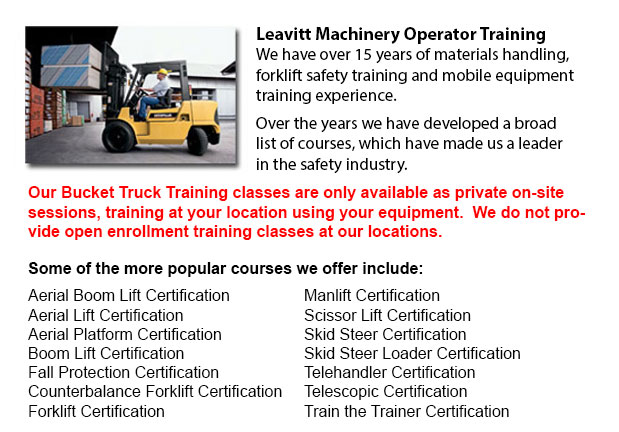
Bucket Truck Training Avondale - The Vehicle-Mounted Aerial Work Platform or likewise called bucket truck training program is designed to lessen the risk of incident and personal injury when working with or in close proximity to bucket trucks by efficiently training operators who are qualified. An aerial lift device is whatever vehicle-mounted device, articulating or telescoping, or both, that is utilized to position workers to reach places that will otherwise be inaccessible. Aerial lift devices are used in order to elevate personnel to above-ground work sites.
The program aims to provide operators with the knowledge, skills, abilities, and training materials required in order to safely and efficiently operate vehicle-mounted aerial work platforms.
The program comprises a classroom training session and a hands-on training session. To be able to become certified, participants must be successful in both parts. A full-size certificate and a wallet-size certificate would be given upon completing the program.
The types of lifts examined in the program consist of Aerial lift devices are usually constructed with wood, metal, fiberglass, reinforced plastic or other materials.
Definitions
Articulating boom platform: many hinged boom sections.
Extensible boom platform: has an extensible or telescopic boom.
Platform: the part of an aerial device which is designed to carry personnel.
Mobile unit: any aerial device along with its components like for instance vehicle and related machinery.
Employers have the responsibility to ensure their employee acquire correct training prior to operating aerial devices. Employees should make sure they likewise receive the required training and that they do not operate lift devices if they are not authorized to do so. Workers must make sure that they wear the correct protective equipment while working from the platform.
The course content used in the bucket truck training program comprises the operation of the vehicle-mounted aerial work platform, safe operating practices, pre-shift inspections, use of emergency controls, lifting capacity, and administering theory and practical tests. Operators would know legal requirements under the local and federal regulations.
-
Forklift Certification Courses Avondale
Forklift Certification Courses Avondale - Forklift certification courses really help to be able to make sure that companies using forklifts, follow the local and regional rules. The drivers of the forklift need to go through forklift certification pr... More -
Manlift Certification Avondale
Manlift Certification Avondale - The Elevated Platforms and Manlifts Certification course helps to provide the required training on the work practices, safe operating procedures, rules and regulations regarding the daily activities for the operators... More -
Manlift Operator Training Avondale
Manlift Operator Training Avondale - The aerial lift or manlift is a specialized type of hydraulic platform that is intended to hoist a person vertically giving it an alternate name of a vertical personnel lift. These machinery are widely used for a... More -
Telescopic Training Avondale
Telescopic Training Avondale - Telescopic Handlers are a type of forklift, normally called telehandlers. This machine has been increasing in popularity because of its greater lift heights and its versatility. It is often preferred over the convention... More -
Heavy Equipment Training Avondale
Heavy Equipment Training Avondale - The two most common types of heavy equipment training are classed into the categories of equipment; equipment that is fashioned with rubber tires or those with tracks. The tracked vehicle are heavy duty equipment l... More -
Aerial Lift Train the Trainer Avondale
Aerial Lift Train the Trainer Avondale - The Aerial Lifts Train the Trainer Certification Program would teach trainers how to efficiently train operators in safe industrial mobile equipment operation. Trainers are provided with in-depth instruction a... More -
Overhead Crane Safety Training Avondale
Overhead Crane Safety Training Avondale - The overhead crane safety training program is meant to equip the operators with the right knowledge and skills in the areas of: crane safety measures, accident avoidance, materials handling, and stock and equ... More -
Heavy Equipment Training Schools Avondale
Heavy Equipment Training Schools Avondale - When choosing an operator training course, there are numerous heavy equipment training schools to select from. In order to ascertain the qualifications you would attain, it is very important to check some a... More

Forklift Training Avondale
TOLL FREE: 1-888-254-6157
Avondale, Arizona
forkliftcertificationavondale.com
Email Us
About Us


